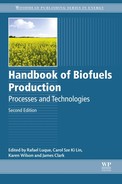8.4. Microbial oil production in fed-batch cultures
A successful fed-batch strategy presupposes choosing an efficient fermentation medium and an appropriate feeding mode. Fed-batch cultures could lead to higher cell densities than batch cultures and simultaneously alleviate the inhibitory effect caused by high nutrient concentration by regulating the flow rate of the feeding medium. Fed-batch operations, depending on the feeding mode that is implemented, can be categorized into processes without feedback control and processes with feedback control (Yamanè and Shimizu, 1984). The production of high lipid concentrations and intracellular contents depends on the C/N ratio employed at the beginning of the fermentation and during the feeding stage. Maintaining a desirable C/N ratio and a constant carbon source concentration in the bioreactor during the feeding stage of a fed-batch operation could enhance lipid biosynthesis and productivity. The nutrient that is most frequently limited is nitrogen, and in a few cases phosphorus, zinc, or ferrous ion.
Literature-cited publications have focused on the development of fed-batch processes for SCO production using various feeding strategies. The application of fed-batch processes with feedback control has not been addressed extensively though. Zhang et al. (2011b) carried out fed-batch fermentations for SCO production in a 30-L bioreactor with Cryptococcus curvatus O3 using glucose as the sole carbon source and obtained a total dry weight, lipid content, and lipid productivity of 104.1 g/L, 82.7% (w/w), and 0.47 g/L/h, respectively. Intermittent feeding of a highly concentrated glucose solution was employed. Li et al. (2007) developed a fed-batch process with a nutrient-rich initial substrate and a sole carbon source intermittent feeding in a 15-L bioreactor. A final concentration of 106.5 g/L of total dry weight was achieved with 67.5% (w/w) SCO content and 0.54 g/L/h of SCO productivity.
Meesters et al. (1996) employed a two stage fed-batch fermentation process using glycerol as carbon source to produce high cell densities of 118 g/L with a lipid production rate of 0.59 g/L/h and a low cellular lipid content of 25% (w/w). A large inoculum was used in order to decrease the lag phase. Higher total dry weights (185 g/L and 153 g/L) with reasonably high lipid contents (40% and 54%, w/w) have been achieved in other studies employing fed-batch fermentations with the yeast strains Rhodotorula glutinis and Lipomyces starkeyi, respectively (Pan et al., 1986; Yamauchi et al., 1983). Pan et al. (1986) employed a fed-batch technique without feedback control where the feeding solution (containing 600 g/L glucose, 20 g/L yeast extract, and 9 g/L MgSO4·7H2O) was intermittently added. The relatively low-lipid content obtained could be attributed to the high concentration of nutrients added during feeding. The fed-batch process employed by Yamauchi et al. (1983) was based on ammonium ion limitation. Specifically, when the concentration of the ammonium ion in the cultivation medium was deficient after 48 h, a TDW of 153 g/L with a lipid content of 83 g/L was achieved.
..................Content has been hidden....................
You can't read the all page of ebook, please click here login for view all page.
